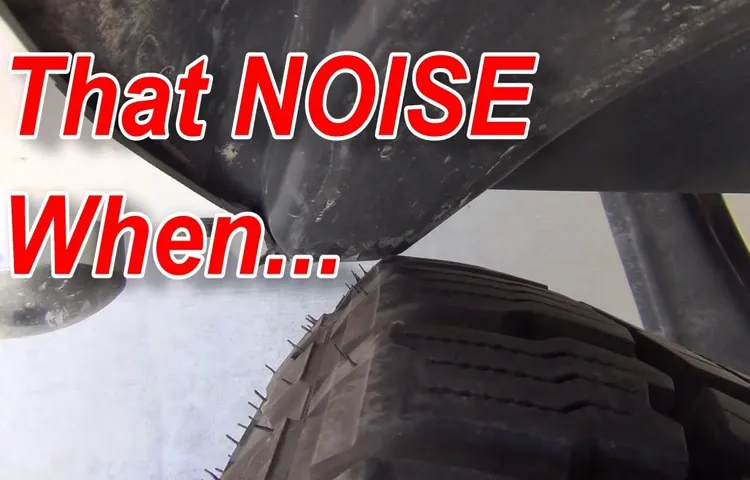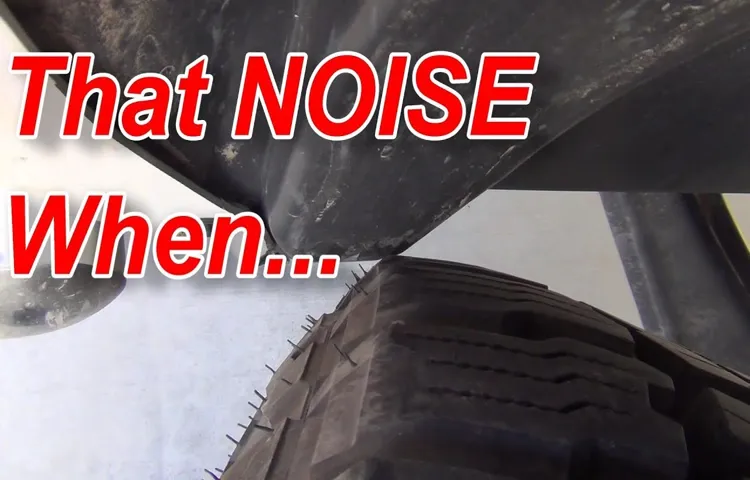Tire rub is a common problem that can cause serious damage to your vehicle if left unaddressed. It happens when your tire rubs against the body of your car, causing wear and tear on both the tire and the vehicle’s body. This can lead to costly repairs and even affect your driving experience.
That’s why it’s important to know how to fix tire rub before it becomes a bigger issue. In this comprehensive guide, we’ll explore the causes of tire rub, how to identify it, and most importantly, how to fix it. So, buckle up and get ready to become a tire rub expert!
Identifying the Cause of Tire Rub
If you have experienced tire rub, it’s essential to identify the cause and fix it promptly to prevent more significant issues. The most common reason for tire rub is improper tire size, which can lead to tires rubbing against fenders or suspension components. To fix this, you may need to get new, properly sized tires or adjust your vehicle’s suspension.
Another possible cause of tire rub is worn or damaged suspension components. In this case, it’s crucial to have your car inspected by a mechanic to identify any worn parts that need replacing. Additionally, if you have installed aftermarket wheels or tires, they may rub against the fenders, causing tire rub.
You can fix this issue by either installing wheel spacers or adjusting the suspension to create more clearance. By identifying the cause of tire rub and fixing it promptly, you can avoid further damage to your tires and ensure a safe driving experience on the road.
Check Tire Size and Fit
One of the most common reasons for tire rub is improper tire fit. It’s essential to check the size of your tire and make sure it’s compatible with your vehicle. If you’re experiencing tire rub, the first thing to do is to check your tire’s size and whether it’s the correct fit for your car.
A tire that’s too big or small can cause the tire to rub against the wheel well or suspension, which can result in dangerous driving conditions. You should also check the tire pressure to ensure it’s at the manufacturers recommended level. Properly inflated tires help the tire maintain its shape, which reduces the risk of tire rubbing.
Finally, you can try to tighten any loose screws or bolts in the wheel well area, which can also contribute to tire rubbing. By taking these steps, you can identify and solve the root cause of tire rubbing, leading to a safer and more comfortable driving experience.

Inspect Suspension Components
When you notice your tire rubbing against the wheel well, it’s essential to identify the cause to avoid significant damage and stay safe on the road. Suspension components could be the culprit behind tire rub, so it’s crucial to inspect them closely. Look for any wear and tear on the shocks, struts, and springs.
Properly functioning suspension components help maintain a stable ride, preventing the tires from rubbing or making any contact with the car’s body. If you notice any damage or abnormality in the suspension system, it’s best to take your vehicle to a professional mechanic. Don’t ignore the issue as it may lead to more significant problems in the future.
Taking care of your suspension system is a vital part of keeping your car in top condition, ensuring your safety on the road.
Fixing Tire Rub
If you are experiencing tire rub, don’t worry, it’s a common problem that can be fixed. Firstly, check for any objects that might be lodged between the tire and wheel well. If there aren’t any, then you might need to adjust the suspension or raise the vehicle’s height.
Uneven suspension can cause the vehicle to lean and compress one side of the tire against the wheel well, leading to tire rub. Alternatively, you can install wheel spacers or adjust the camber angle. Although these methods might solve the problem, it’s important to get a professional to assess the issue to ensure a safe and long-term solution.
Remember, tire rub can be detrimental to your tire’s longevity and performance, and should be taken care of as soon as possible.
Adjusting Wheel Alignment
When you’re driving and you hear a strange scraping or rubbing sound coming from your tires, it’s likely your wheel alignment needs adjusting. Misaligned wheels can cause uneven tire wear, which leads to rubbing and other potential issues. This problem is especially common in older cars or ones that have recently experienced a rough ride.
Fortunately, fixing tire rub is usually a simple matter of adjusting your wheel alignment. Just take your car to a qualified mechanic or tire center and they can inspect your tires and make any necessary adjustments. In the end, it will ensure your car drives smoothly and safely, without any pesky tire rubbing.
So, if you’re experiencing this frustrating issue, don’t hesitate to take action and get your wheels aligned.
Trimming Fender Liners
If you’re experiencing tire rub on your car, one solution that many DIY enthusiasts turn to is trimming the fender liners. Fender liners are designed to protect the inner workings of your car from debris, but they can also cause problems when it comes to tire clearance. Trimming the fender liners is a straightforward process that involves removing a portion of the liner to create more space for your tires.
However, it’s essential to be cautious when trimming as you want to maintain a good level of protection for your car. Begin by checking your car’s owner manual to make sure you’re trimming in the right spots, and don’t remove too much material, which could compromise the liner’s function. It’s also best to use a sharp utility knife and take your time to ensure a clean cut.
With a little bit of patience, you can eliminate any tire rub issues and get back on the road with peace of mind.
Installing Wheel Spacers
Wheel spacers are a great way to fix tire rub without having to replace your wheels. These spacers are installed on the wheel hub, and they effectively push the wheel away from the hub. This extra space between the hub and wheel allows for wider tires to fit without rubbing against the wheel well.
Not only do wheel spacers provide a quick fix for tire rub, but they can also improve handling by widening the vehicle’s stance and reducing body roll. Installing wheel spacers may seem daunting, but with the right tools and a bit of patience, it can be a simple and effective solution for fixing tire rub. Just be sure to research the proper size and brand of wheel spacers for your vehicle to ensure safe and optimal performance.
Preventing Future Tire Rub
If you’re dealing with tire rub on your vehicle, it’s important to take action before it leads to bigger problems like uneven wear, alignment issues, or even a blown tire. One of the simplest ways to fix tire rub is by adjusting the ride height of your vehicle. If your suspension is too low, you may need to raise it a bit to ensure there’s enough clearance between the tire and the fender.
Another option is to make sure your wheels and tires are the correct size for your vehicle. Using larger or wider wheels can cause interference with other parts of the car, leading to tire rub. Additionally, be sure to keep your suspension and steering components in good condition, since worn parts can cause misalignment and rubbing.
Regularly checking your tire pressure and rotating your tires can also help prevent and detect issues that may lead to tire rub. By taking these steps, you can avoid the headache and expense of fixing an even bigger problem down the road, while also ensuring a safe and smooth ride.
Regular Maintenance
Regular maintenance is essential to prevent future tire rub. Over time, wear and tear will inevitably occur on your vehicle’s tires. However, if you keep up with regular maintenance, you can avoid the annoying and potentially dangerous issue of tire rub.
It’s important to regularly inspect your tires, checking for bulges, cuts, and cracks. Additionally, keeping your tires properly inflated can help prevent damage. Another crucial aspect of tire maintenance is wheel alignment.
Proper wheel alignment can help ensure that your tires wear evenly, avoiding uneven wear that can lead to tire rub. By taking these preventative measures, you can save yourself time, money, and hassle in the long run. So, make sure to stay on top of your regular tire maintenance to avoid the frustrating and dangerous issue of tire rub.
Selecting Proper Tires and Wheels
When it comes to preventing future tire rub, selecting the proper tires and wheels is key. It’s important to choose tires that are the correct size and have adequate clearance for your vehicle’s suspension. Additionally, selecting the right offset and backspacing for your wheels can help prevent rubbing.
Tire rub can cause damage to your tires and suspension, and can also lead to decreased performance and safety issues. By taking the time to select the appropriate tires and wheels, you can ensure a smooth and safe ride, while also preventing any costly damage down the road. So, next time you’re in the market for new tires or wheels, be sure to do your research and choose wisely.
Conclusion
At the end of the day, fixing tire rub comes down to a simple formula: identify the problem, find the cause, and implement a solution. It’s like a game of detective work, but with tires instead of crime scenes. With a little bit of know-how and some elbow grease, you can banish tire rub from your life forever.
And if all else fails, you can always just put on some earplugs and pretend it’s a funky drum solo. Keep cruising, rubber side down!”
FAQs
What causes tire rub?
Tire rub can be caused by worn out suspension, incorrect tire size, or damage to the wheel well or tire.
How do I know if my tires are rubbing?
If you hear a scraping or grinding sound when turning or going over bumps, or if you notice frayed or worn spots on your tires, you may have a tire rub issue.
Can tire rub damage my vehicle?
Yes, depending on the severity of the rub and how long it goes unnoticed, tire rub can cause damage to the wheel well, fender, tires, and suspension parts.
How do I fix tire rub?
First, determine the cause of the tire rub. If it’s due to worn out suspension or incorrect tire size, those issues will need to be addressed. If it’s a damage to the wheel well or tire, the affected parts will need to be repaired or replaced.
Can tire rub be prevented?
Yes, it can be prevented by making sure the correct tire size is used, regularly inspecting the suspension and wheel well for damage, and avoiding driving over rough or uneven terrain.
Can I drive with tire rub?
It’s not recommended to drive with tire rub as it can cause further damage to your vehicle and potentially lead to a dangerous situation on the road.
How much does it cost to fix tire rub?
The cost of fixing tire rub will vary depending on the cause and severity of the issue, as well as the make and model of your vehicle. It’s best to get an estimate from a trusted mechanic or repair shop.

